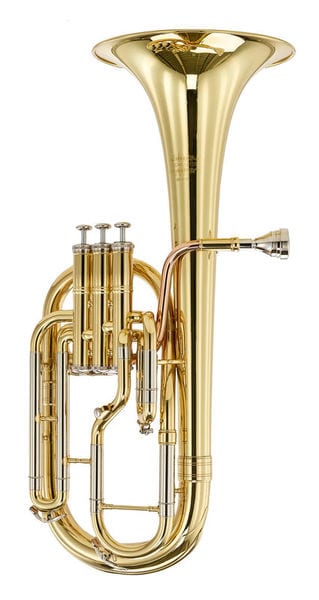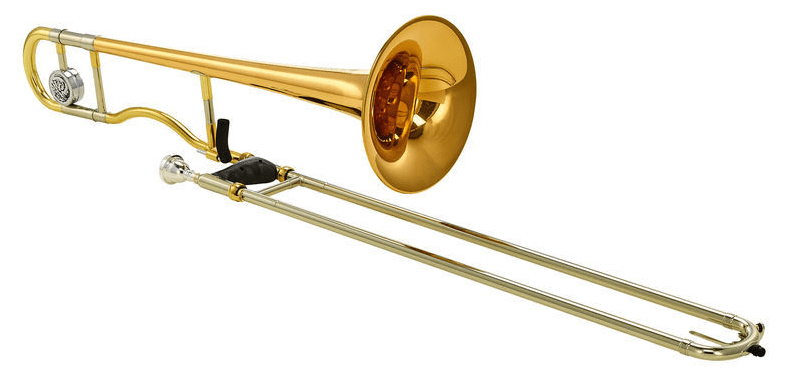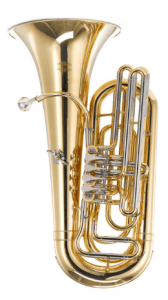What Instrument Is Not in the Brass Family
Contumely instruments are instruments that are made of brass, correct? Sounds logical but information technology isn't true in every sense and very ofttimes woodwinds such every bit the saxophone and even clarinets are mistakenly thrown into the brass category. Let's discuss a option of the almost mutual brass instruments: What are their peculiarities? Here are a few tips, thoughts and sound samples, just for you!
#KissMyBrass ??
1. Cornet – universally popular

Mayhap information technology's because the cornet is the smallest of the traditional brass instruments, but 1 thing is clear: it is the most played instrument among contumely musicians. Well-nigh 30% are using this icon of brass instruments. The cornet has a relatively lyrical, velvety and circular sound and blends harmoniously into the contumely section. A slight distinction is found between the smaller Eb cornet and the larger Bb cornet (listen to the sound sample beneath). For high notes the cornet reaches its natural limits. In improver, many musicians hold that it is difficult to play because of the deeper, V-shaped cup in the mouthpiece.

By loading the video, y'all agree to YouTube'due south privacy policy.
Learn more
Load video
ii. Trumpet – in the first row

The trumpet, a close relative of the cornet: The playing style is similar, almost identical, apart from the somewhat different approach. The trumpet is longer and delivers a brighter, more than present and clearer tone. For this reason alone it is preferred in the brass department as a soloist. And in terms of volume, the trumpet is also far more than dominant. The notes snap less easily than with a cornet, making jazzy, "half-muted" and"coloured" notes easier to play.

By loading the video, you agree to YouTube'southward privacy policy.
Learn more
Load video
3. Flugelhorn – the versatile, well-sounding one

Some other relative of the brass family is the flugelhorn. Basically, the fashion of playing too does not differ from the trumpet or the cornet, however this merits is debatable. The near significant difference lies in the mouthpiece. A flugelhorn mouthpiece, with a insufficiently large inner bore, leads to higher air consumption and air utilize. Really, it should swing the sound pleasantly due to the lower bravado resistance.

Past loading the video, you agree to YouTube's privacy policy.
Learn more
Load video
4. Alto / Tenor Horn – the joyful harmony

A pretty skillful-natured comrade is the TenorHorn (unremarkably in Eb or Bb); in terms of its audio character, it's not unremarkably a contumely instrument that is put in the foreground. Rather, it is more often than not used every bit a typical accompanying instrument. On the Eb horn, the bell and the mouthpiece are both directed upwards; therefore it islike shooting fish in a barrel to play sitting down. The tenor horn acts as a bridge in the contumely department, calculation beautifulharmony to the composition.

By loading the video, you agree to YouTube's privacy policy.
Larn more than
Load video
five. Euphonium – good voicing in the mid-tone section

The euphonium sings one octave lower than the trumpet and 1 higher than the tuba. This instrument requires a special mouthpiece with cup sizes that are ordinarily deeper and more conical in nature. The most important difference to other brass instruments is the euphonium's compensatingmachinery: Depending on the model, 3 orfour val ves are installed and this makes forintonation which is very good and differentiated.

By loading the video, you lot concord to YouTube'south privacy policy.
Learn more
Load video
vi. Trombone – the infinite

A typical instrument from the brass section is the trombone. It is mostly said to be the easiest musical instrument of the brass family unit. The tones are not controlled by valves, merely by the slide instead. And that not simply allows these typical fatigued tones, simply as well intermediate ones. In add-on to the mastery of breathing and technique, having an excellent ear for pitch is one of the most important requirements.

By loading the video, you concur to YouTube'southward privacy policy.
Larn more
Load video
7. Tuba & Sousaphone – from deep downwardly

The sounds that come from atuba are thunderous and other-worldly. Some people are even convinced that they come up from Heaven above, which is ironic because the annals is at the very lesser of the brass department. The special feature of these beasts is that they have three to six valves and a particularly wide scale length and thus a much wider diameter. Information technology is played via a wide and deep (cup– or bowl-shaped) mouthpiece. In that location are many different designs, from the marching tune of the sousaphone to earth-shaking tones of thecontrabass tuba (BB-flat or CC tuba, see video below), which has at least a length of 580 cm. That'southward almost six meters of brass in your easily!

Past loading the video, you concord to YouTube's privacy policy.
Learn more
Load video
Consultation
If y'all still have questions or would like to be advised, then nosotros are gladly at that place to help! Come up by our brass section in Treppendorf or contact us past eastward-mail or bytelephone: (09546) 9223 26!
? To all contumely instruments on thomann.de
From 24 to 30 April 2019 #KissMyBrass is all about brass instruments. On Facebook and Instagram and here on the t.blog you will discover sectional deals, helpful articles and all kinds ofentertaining content.
Source: https://www.thomann.de/blog/en/7-brass-instruments-differences-in-sound-and-playing-style/
0 Response to "What Instrument Is Not in the Brass Family"
Post a Comment